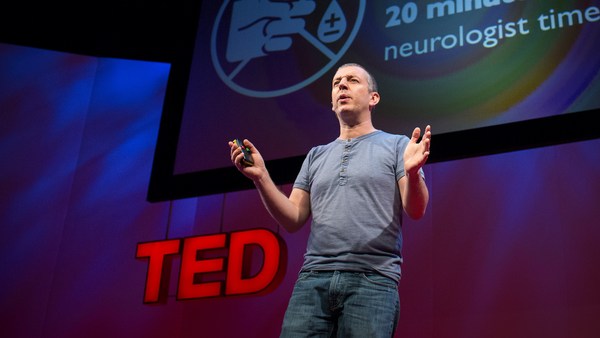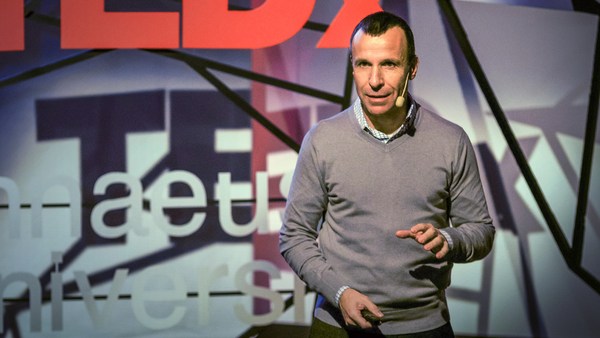In India, we have these huge families. I bet a lot of you all must have heard about it. Which means that there are a lot of family events. So as a child, my parents used to drag me to these family events.
But the one thing that I always looked forward to was playing around with my cousins. And there was always this one uncle who used to be there, always ready, jumping around with us, having games for us, making us kids have the time of our lives. This man was extremely successful: he was confident and powerful. But then I saw this hale and hearty person deteriorate in health. He was diagnosed with Parkinson's.
Parkinson's is a disease that causes degeneration of the nervous system, which means that this person who used to be independent suddenly finds tasks like drinking coffee, because of tremors, much more difficult. My uncle started using a walker to walk, and to take a turn, he literally had to take one step at a time, like this, and it took forever. So this person, who used to be the center of attention in every family gathering, was suddenly hiding behind people. He was hiding from the pitiful look in people's eyes.
And he's not the only one in the world. Every year, 60,000 people are newly diagnosed with Parkinson's, and this number is only rising. As designers, we dream that our designs solve these multifaceted problems, one solution that solves it all, but it need not always be like that. You can also target simple problems and create small solutions for them and eventually make a big impact. So my aim here was to not cure Parkinson's, but to make their everyday tasks much more simple, and then make an impact.
Well, the first thing I targeted was tremors, right? My uncle told me that he had stopped drinking coffee or tea in public just out of embarrassment, so, well, I designed the no-spill cup. It works just purely on its form. The curve on top deflects the liquid back inside every time they have tremors, and this keeps the liquid inside compared to a normal cup. But the key here is that it is not tagged as a Parkinson's patient product. It looks like a cup that could be used by you, me, any clumsy person, and that makes it much more comforting for them to use, to blend in. So, well, one problem solved, many more to go.
All this while, I was interviewing him, questioning him, and then I realized that I was getting very superficial information, or just answers to my questions. But I really needed to dig deeper to get a new perspective. So I thought, well, let's observe him in his daily tasks, while he's eating, while he's watching TV. And then, when I was actually observing him walking to his dining table, it struck me, this man who finds it so difficult to walk on flat land, how does he climb a staircase? Because in India we do not have a fancy rail that takes you up a staircase like in the developed countries. One actually has to climb the stairs. So he told me, "Well, let me show you how I do it." Let's take a look at what I saw.
So he took really long to reach this position, and then all this while, I'm thinking, "Oh my God, is he really going to do it? Is he really, really going to do it without his walker?" And then ...
(Laughter)
And the turns, he took them so easily.
So -- shocked? Well, I was too. So this person who could not walk on flat land was suddenly a pro at climbing stairs.
On researching this, I realized that it's because it's a continuous motion. There's this other man who also suffers from the same symptoms and uses a walker, but the moment he's put on a cycle, all his symptoms vanish, because it is a continuous motion. So the key for me was to translate this feeling of walking on a staircase back to flat land. And a lot of ideas were tested and tried on him, but the one that finally worked was this one. Let's take a look.
(Laughter)
(Applause)
He walked faster, right?
(Applause)
I call this the staircase illusion, and actually when the staircase illusion abruptly ended, he froze, and this is called freezing of gait. So it happens a lot, so why not have a staircase illusion flowing through all their rooms, making them feel much more confident? You know, technology is not always it. What we need are human-centered solutions. I could have easily made it into a projection, or a Google Glass, or something like that. But I stuck to simple print on the floor. This print could be taken into hospitals to make them feel much more welcome.
What I wish to do is make every Parkinson's patient feel like my uncle felt that day. He told me that I made him feel like his old self again.
"Smart" in today's world has become synonymous to high tech, and the world is only getting smarter and smarter day by day. But why can't smart be something that's simple and yet effective? All we need is a little bit of empathy and some curiosity, to go out there, observe. But let's not stop at that. Let's find these complex problems. Don't be scared of them. Break them, boil them down into much smaller problems, and then find simple solutions for them. Test these solutions, fail if needed, but with newer insights to make it better. Imagine what we all could do if we all came up with simple solutions. What would the world be like if we combined all our simple solutions? Let's make a smarter world, but with simplicity.
Thank you.
(Applause)





